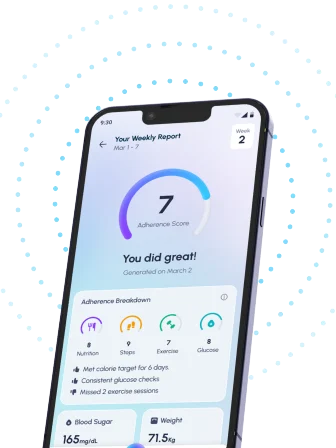Table of Contents
- Diabetes & Watery Eyes: Recognizing the Signs
- Watery Eyes and Diabetes: When to See a Doctor?
- Is it Diabetes? Understanding Watery Eyes as a Symptom
- Diabetes-Related Eye Problems: A Comprehensive Guide
- Managing Diabetes: Addressing Watery Eyes and Other Complications
- Frequently Asked Questions
- References
Experiencing watery eyes can be annoying, but did you know it could sometimes be linked to a more serious underlying condition like diabetes? Many people overlook the connection between diabetes and watery eyes, often dismissing the symptom as allergies or a minor irritation. However, understanding when watery eyes might signal a diabetic complication is crucial for managing your health effectively. This blog post will explore the potential link between these two seemingly unrelated issues, helping you determine when it’s time to seek professional medical attention. Let’s delve into the details and learn how to best protect your eye health.
Diabetes & Watery Eyes: Recognizing the Signs
Understanding the Connection
Watery eyes, or excessive tearing, might seem unrelated to diabetes, but in certain cases, they can be a subtle yet important symptom. This is particularly relevant in regions like India and other tropical countries where undiagnosed diabetes is prevalent. Did you know that globally, 50% of diabetes cases remain undiagnosed? (Source). This alarming statistic highlights the importance of recognizing potential symptoms, including seemingly minor ones like persistent watery eyes.
Potential Causes
Several factors linking diabetes and watery eyes exist. High blood sugar levels can damage nerves, including those controlling tear production. This can lead to either excessive tearing (epiphora) or, conversely, dry eyes. Additionally, diabetic retinopathy, a common complication of diabetes, can sometimes cause eye irritation and increased tearing. Infections, often more common in individuals with compromised immune systems due to poorly managed diabetes, may also contribute. In tropical climates, factors like heat, humidity and environmental irritants can exacerbate existing eye problems related to diabetes.
When to Seek Help
Persistent watery eyes, especially when accompanied by blurred vision, redness, pain, or changes in vision, warrants immediate medical attention. Don’t delay seeking professional help, especially in tropical regions where infections can spread more rapidly. Early diagnosis and management of both diabetes and related eye conditions can help prevent long-term complications and preserve your vision. Regular eye exams are crucial, particularly if you have diabetes or live in a climate that increases the likelihood of eye infections. Consult an ophthalmologist or your primary care physician to address your concerns and receive appropriate care. For more information on protecting your vision, check out our guide on How to Protect Your Vision with Diabetes: Essential Eye Care Tips. As you age, managing diabetes can present unique challenges. Learn more about Managing Diabetes as You Age: Challenges and Solutions.
Watery Eyes and Diabetes: When to See a Doctor?
Watery eyes aren’t always a cause for alarm, but when you have diabetes, it’s crucial to pay attention to even seemingly minor symptoms. Diabetes affects millions globally, with a significant portion – 61% – of those living with the condition aged between 20 and 64, according to the International Diabetes Federation. In India and other tropical countries, where diabetes prevalence is high, understanding the potential links between diabetes and eye health is particularly important.
Understanding the Connection
High blood sugar levels, a hallmark of diabetes, can damage blood vessels throughout the body, including those in the eyes. This damage can lead to various eye problems, and watery eyes could be one of the early warning signs. While watery eyes alone aren’t diagnostic of a serious complication, they might accompany other symptoms such as blurry vision, eye pain, or changes in vision. These symptoms could indicate conditions like diabetic retinopathy, a leading cause of blindness, or other eye infections that are more prevalent or severe in individuals with diabetes. The elderly population with diabetes, representing 39% of those affected, are particularly vulnerable to these complications. Regular eye screenings are vital, and you might find our article on How Often is Diabetic Eye Screening? helpful.
When to Seek Medical Attention
Persistent watery eyes accompanied by any of the above symptoms warrant immediate medical attention. In hot and humid climates prevalent in many Indian and tropical countries, eye infections are more common, and diabetes can exacerbate these infections. Therefore, don’t delay seeking help if your watery eyes are persistent, accompanied by discomfort, or if you notice changes in your vision. Early diagnosis and treatment are crucial for preventing serious complications. It’s also important to understand when to seek help for dry eyes, a condition that can sometimes be confused with watery eyes. See our article on When Should I Consult an Eye Care Professional for Dry Eyes? for more information.
Taking Action
If you experience persistent watery eyes and have diabetes, consult an ophthalmologist or your doctor promptly. Early detection and management of diabetic eye diseases can significantly reduce the risk of vision loss. Don’t hesitate to reach out to a healthcare professional – your vision is precious.
Is it Diabetes? Understanding Watery Eyes as a Symptom
Watery eyes, or excessive tearing, aren’t typically considered a primary symptom of diabetes. However, in tropical and Indian contexts, where certain eye infections are more prevalent, and considering the high prevalence of diabetes, it’s crucial to understand the potential indirect connections. Diabetes significantly impacts various bodily systems, and eye problems can be a concerning indicator of underlying complications.
Diabetes and Eye Health Complications
One major link is the increased risk of kidney disease associated with diabetes. Nearly 30% of individuals with diabetes develop diabetic nephropathy, a condition damaging the kidneys. As kidney function declines, it can affect the body’s fluid balance, potentially leading to increased tear production or other eye-related issues. This isn’t to say watery eyes directly *cause* diabetes, but they could signal a concerning complication like kidney disease requiring immediate medical attention. For more information on other potential symptoms, you might find our article on 10 Early Signs and Symptoms of Diabetes? helpful.
Other Contributing Factors in Tropical Climates
In hot and humid climates prevalent in India and other tropical regions, environmental factors can exacerbate eye irritation. Dust, pollen, and infections can cause watery eyes, making it challenging to distinguish between simple irritation and a symptom related to a diabetic complication. Therefore, regular eye check-ups are even more crucial for individuals with diabetes living in these regions.
When to Seek Medical Help
If you have diabetes and experience persistent or excessive watery eyes, especially accompanied by blurred vision, changes in vision, or other symptoms like frequent urination or increased thirst, seek immediate medical advice. Don’t delay; early diagnosis and treatment of diabetic complications are critical for preventing long-term damage. Consult your ophthalmologist and diabetologist promptly for a thorough evaluation. It’s also worth noting that experiencing cold feet can sometimes be another indicator, as discussed in our article, Are Cold Feet a Symptom of Diabetes?
Diabetes-Related Eye Problems: A Comprehensive Guide
Understanding the Link Between Diabetes and Eye Health
Diabetes significantly impacts various bodily systems, and the eyes are no exception. High blood sugar levels can damage the blood vessels in the retina, leading to various eye complications. One such symptom that can occur is watery eyes, often accompanied by blurry vision, and even floaters or halos around lights. While watery eyes themselves aren’t always directly indicative of a serious diabetic eye problem, they can be a warning sign, particularly when coupled with other symptoms. It’s crucial to remember that early detection and treatment are vital in preventing irreversible vision loss.
Common Diabetic Eye Conditions Manifesting as Watery Eyes
Diabetic retinopathy, a common complication, involves damage to the blood vessels in the retina. This can cause swelling and leakage, potentially leading to blurry vision and watery eyes. Another condition, diabetic macular edema, affects the macula (the central part of the retina responsible for sharp, central vision), also potentially causing watery eyes along with vision impairment. Given the high prevalence of diabetes in India and other tropical countries, awareness of these conditions is paramount. The increased risk of sleep apnea, a sleep disorder significantly linked to diabetes (a 70% increased risk), can further exacerbate these eye problems due to fluctuating blood sugar levels throughout the night. Managing blood sugar levels effectively, as discussed in Tips for Parents of Kids with Type 1 Diabetes: Complete Guide, is crucial for overall health, including eye health.
When to Seek Medical Attention
If you have diabetes and experience persistent watery eyes, especially accompanied by blurry vision, floaters, or changes in your vision’s clarity, it’s essential to consult an ophthalmologist immediately. Early intervention can significantly improve the outcome and help prevent serious complications. In India and other tropical regions, access to quality eye care can vary. Therefore, proactive monitoring and prompt medical attention are crucial for maintaining good eye health. Don’t hesitate to schedule a comprehensive eye exam; your vision is invaluable. Maintaining good health while traveling can also be challenging, especially with diabetes; see Traveling with Diabetes: Essential Tips for a Safe & Healthy Journey for helpful advice.
Managing Diabetes: Addressing Watery Eyes and Other Complications
Diabetes significantly impacts daily life, with complications leading to a concerning 9-12% loss in work productivity due to absenteeism in many regions. One often overlooked complication is watery eyes, a symptom that can stem from various underlying issues, particularly prevalent in hot and humid climates common across India and tropical countries. Understanding when watery eyes warrant medical attention is crucial for effective diabetes management.
Understanding the Connection
Watery eyes in individuals with diabetes aren’t always directly caused by the disease itself. Instead, they can be a symptom of related complications. For example, diabetic retinopathy, a condition affecting the eyes, can cause increased tear production. Additionally, dry eye syndrome, often exacerbated by environmental factors like sun and dust prevalent in many parts of India and tropical regions, can lead to compensatory watery eyes as the eyes try to lubricate themselves. Infections, another common concern in warmer climates, can further complicate matters.
When to Seek Medical Help
Persistent watery eyes, accompanied by blurred vision, pain, redness, or changes in vision, require immediate attention. These symptoms might indicate serious complications like glaucoma or an infection. Likewise, if your watery eyes are accompanied by other diabetes-related symptoms like frequent urination, excessive thirst, or unexplained weight loss, it’s vital to contact your doctor immediately. Ignoring these symptoms can lead to irreversible damage. For more information on managing diabetes effectively, check out our article on 10 Proven Tips for Effective Diabetes Management.
Seeking Regional Expertise
In India and tropical countries, access to quality healthcare can vary. Proactive management is key. Regular check-ups with an ophthalmologist and your diabetologist are essential for early detection and treatment of eye-related complications. Don’t hesitate to seek medical attention if you are experiencing persistent watery eyes alongside other concerning symptoms – your eye health is directly linked to your overall well-being, particularly when managing diabetes. Avoiding 5 Common Mistakes People Make in Managing Diabetes is also crucial for maintaining good health.
Frequently Asked Questions on Watery Eyes Diabetes
Q1. Can watery eyes be a symptom of diabetes?
While not a primary symptom, watery eyes can indicate diabetes-related complications. High blood sugar damages blood vessels, impacting tear production and potentially causing excessive tearing or dryness.
Q2. What are the potential eye complications related to diabetes?
High blood sugar can lead to diabetic retinopathy (damage to blood vessels in the retina) and increase the risk of eye infections. These complications often cause eye irritation and discomfort.
Q3. When should I seek medical attention for watery eyes?
Seek immediate medical attention if you experience persistent watery eyes, especially if accompanied by blurred vision, pain, redness, or vision changes. Early diagnosis is crucial to prevent vision loss.
Q4. Why are regular eye exams important for people with diabetes, particularly in tropical climates?
Regular eye exams are vital for early detection and management of diabetic eye complications. Tropical climates increase the risk of infections that can worsen eye problems.
Q5. How can I reduce my risk of developing diabetes-related eye complications?
Effectively managing your blood sugar levels through diet, exercise, and medication (if prescribed) is crucial. Regular eye exams also allow for early detection and treatment of any issues.
References
- What is Diabetes: https://www.medschool.lsuhsc.edu/genetics/docs/DIABETES.pdf
- A Practical Guide to Integrated Type 2 Diabetes Care: https://www.hse.ie/eng/services/list/2/primarycare/east-coast-diabetes-service/management-of-type-2-diabetes/diabetes-and-pregnancy/icgp-guide-to-integrated-type-2.pdf




